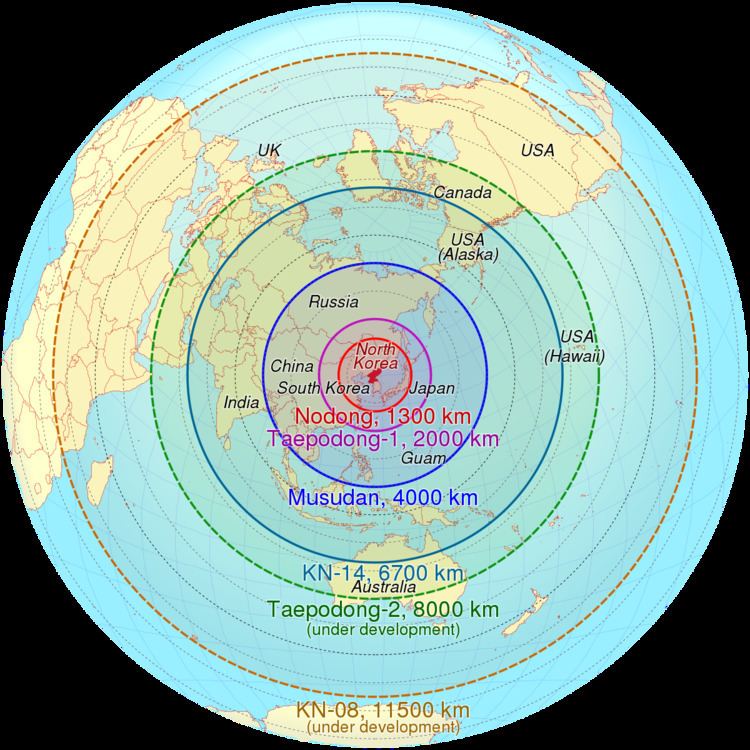Place of origin North Korea Manufacturer North Korea | In service 1998 - present Produced 1990 - present | |
 | ||
Type Mobile medium-range ballistic missile Used by North Korea
Iran (As Shahab-3)
Pakistan (As Hatf 5 Ghauri)
Egypt
Libya (Formerly until the Disarmament of Libya) | ||
The Rodong-1 (spelled Nodong-1 or simply Nodong in South Korea) is a single stage, mobile liquid propellant medium-range ballistic missile developed by North Korea. Developed in the mid-1980s, it is a scaled up adaptation of the Soviet SS-1, more commonly known by its NATO reporting name "Scud".
Overview
Rodong (nodong in South Korea) is the Korean word for "labour". It is used in North Korea to denote the working class in Communist ideology, for example in name of the ruling Workers Party (Rodongdang).
It is believed North Korea obtained Scud-B designs from Egypt and possibly Scud-C designs from China, and reverse-engineered them into a larger, longer-distance weapon dubbed the Rodong. U.S. reconnaissance satellites first detected this type in May 1990 at the Musudan-ri test launch facility.
The precise capabilities and specifications of the missile are unknown; even the fact of its production and deployment are controversial. It is a larger variant of the Scud-B, scaled up so its cross-sectional area is about double that of the Scud, with a diameter of 1.25 metres (4 ft) and a length of 15.6 metres (51 ft).
Its aerodynamic design is stable, so it does not require modern guidance systems. It can only be fueled when vertical, so cannot be fueled before transport as is normal for modern missiles. Its range is estimated as 900 km with a 1000 kg payload to a range of between 1000 km to 1500 km with a 1000 kg payload. However, North Korea test-fired three Rodong-1 missiles consecutively on 5 September 2016 and they all flew for about 1000 km, landing in the Japan Air Defense Identification Zone with high accuracy.Hence, the operating range of Rodong-1 must be somewhere above 1000 km.
It has an estimated CEP of one or two kilometers. North Korea is believed to possess some 300 Rodong missiles and fewer than 50 mobile launchers.
The Rodong-1's technology has been exported to foreign nations (such as Iran and Pakistan) in secrecy on the basis of mutual exchange of technologies, with Iran being the most beneficiary of such technology. Successful variants were tested and deployed by Iran after developing the Shahab-3 which is roughly based on Rodong-1.
Pakistan, however, suffered with repeated failure due to flawed design given in exchange but succeeded in reevaluating the missile's conceptual design and its electronic system in 1998. The Hatf 5 Ghauri missile which is independent of Rodong-1's design, eventually entered in the active military service in 2003.
A few Nodong missiles were launched in the 2006 North Korean missile test, and two in a 2014 test over a range of 650 km.
The Rodong-1 is one of North Korea's most effective ballistic missiles because it is more difficult to intercept by missile defenses. Although it has an estimated range of 1,000–1,500 km (620–930 mi), launches in March 2014 flew only 650 km (400 mi). Their range was shortened by firing at a higher launch angle, which may enable them to avoid interception. The missiles flew to an altitude of 160 km at Mach 7, while U.S. and South Korean Patriot PAC-2/3 interceptors are more specialized to hit Scud-type missiles up to 40 km high. To counter this, South Korea is indigenously developing the long-range surface-to-air missile (L-SAM), and on 8 July 2016 the U.S. agreed to deploy one THAAD missile defense system in Seongju County, in the south of South Korea, by the end of 2017.
